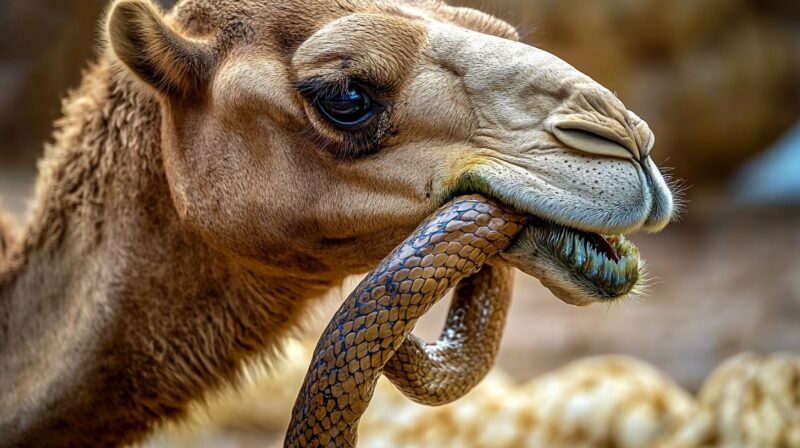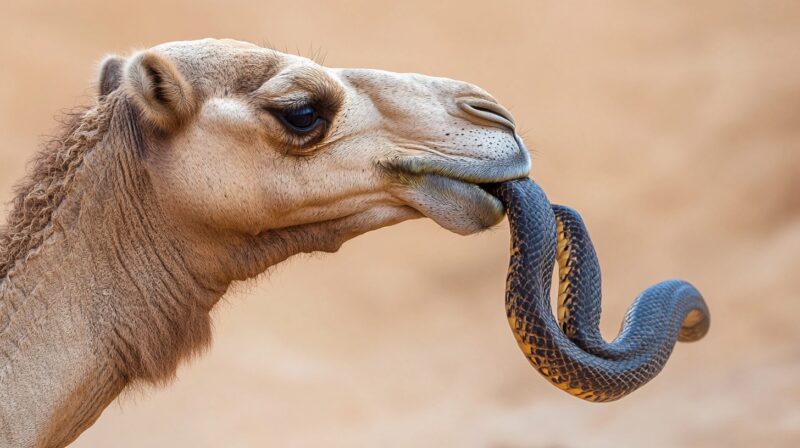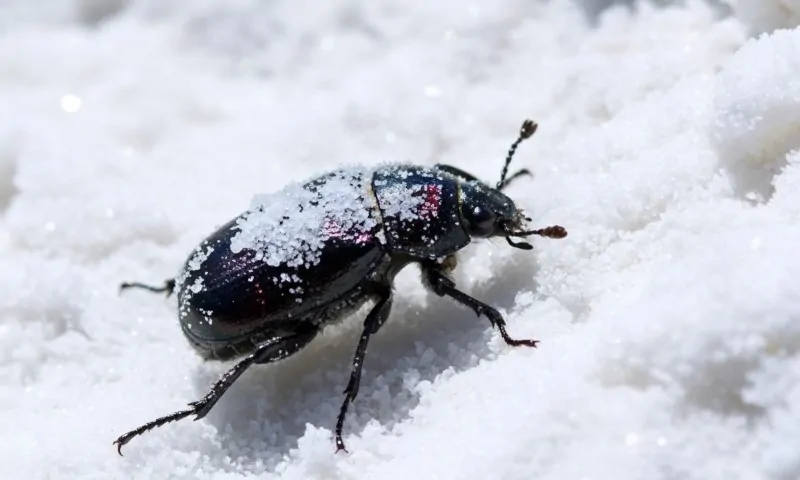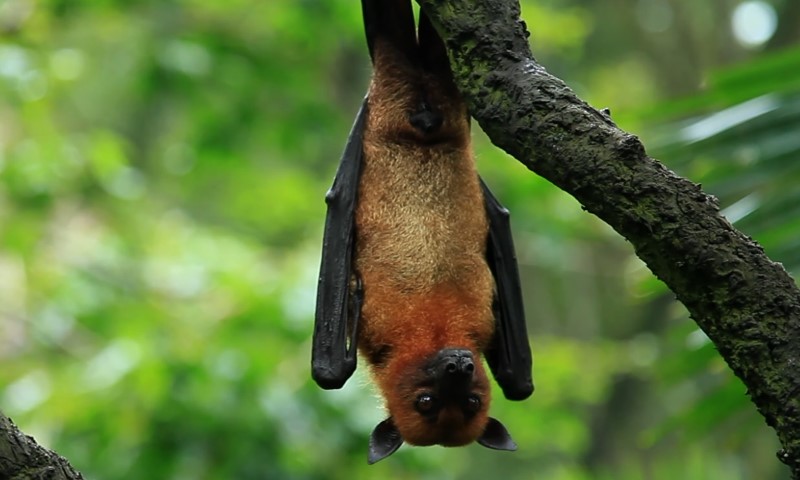The practice of feeding snakes to camels among Arab desert nomads is as surprising as it is intriguing.
This tradition, though unusual, is rooted in desert life and combines cultural and medicinal beliefs.
It has practical purposes developed over centuries to support camel health in the harsh desert environment.
Let us take a look at why are camels eating snakes, and why this is not a problem for locals.
The Tradition and its Historical Roots

For centuries, camels have been essential to Arab nomads, symbolizing endurance and adaptability in the harsh desert.
The bond has led nomadic communities to develop ways to care for camels, especially where veterinary resources are limited.
One such remedy is the practice of feeding snakes to camels, a tradition shaped by necessity and resourcefulness.
Key aspects of this tradition and its historical context include:.
| Aspect | Role/Practice | Purpose | Details |
|---|---|---|---|
| Camel as a Lifeline | Transportation | Essential for desert travel | Enables long-distance movement across deserts |
| Milk Provision | Dietary staple | Provides a consistent source of nutrition | |
| Wool and Meat | Clothing and sustenance | Wool for clothing, occasional meat for diet | |
| Economic Value | Trade and dowries | Significant cultural and economic value | |
| Unique Remedies | Natural Treatments | Health care without veterinary access | Relied on indigenous knowledge and local resources |
| Desert Environment | Source of medicinal solutions | Every desert element considered for its potential health benefits | |
| Medicinal Beliefs on Snakes | Snake Consumption | Immune stimulation | Believed to help camels fight ailments like hayam |
| Snake Properties | Resilience transfer | Nomads believe snakes’ venom or resilience could benefit camels | |
| Resource Scarcity Adaptation | Remote Location | Limited conventional resources | Led to practical solutions using available wildlife |
| Use of Snakes | Readily available in the desert | Snakes used as a treatment option due to their accessibility and benefits | |
| Cultural Respect for Camels | Symbol of Resilience | Cultural and spiritual reverence | Camels represent endurance and survival in harsh conditions |
| Unique Care Practices | Honor central role of camels | Developed specialized treatments |
Hayam – The Disease in Camels

Hayam, often referred to as a hemorrhagic disease, is a common yet troubling ailment that affects camels, particularly those in the Arabian desert environment.
The disease can significantly impact the health and productivity of camels, posing a challenge for nomadic communities who rely heavily on these animals for survival and livelihood.
- Symptoms and Impact:
- Lethargy: Infected camels display extreme tiredness and reduced energy
- Loss of Appetite: Hayam leads to a decrease in food intake
- Weakened Immune Response: The disease compromises the camel’s immune system
For Arab nomads who depend on camels for transportation, milk, meat, and even trading goods, Hayam poses a serious threat.
Managing this disease is essential to maintaining a sustainable lifestyle in the harsh desert climate.
- Immune Stimulation: Nomads believe that the properties within the snake may act as a catalyst
- Revitalization of Energy Levels: Anecdotal reports from nomads suggest that afflicted camels often regain energy and appetite after undergoing this treatment
The Process of Feeding Snakes to Camels
Feeding a snake to a camel is not as simple as it may sound. In fact, it is a process that demands skill, caution, and years of experience.
For nomadic communities, the practice has evolved as a specialized ritual requiring both respect for the desert’s wildlife and a deep understanding of animal behavior.
| # | Step | Description |
|---|---|---|
| 1 | Capturing the Snake | The handler captures the snake in challenging conditions, locating and catching it without harm. |
| 2 | Preparing the Snake for Ingestion | The snake is defanged to ensure safety. Handlers may cut it into smaller pieces for easier ingestion. |
| 3 | Presenting the Snake to the Camel | Handlers gently offer the snake to the camel, creating a calm environment to encourage acceptance. |
| 4 | Encouraging Ingestion | Handlers use positioning and cues to help the camel ingest the snake, as it may initially resist. |
| 5 | Ensuring Safety | Handlers monitor the camel’s comfort and adjust methods as needed to avoid stress or injury. |
Anecdotal Evidence vs. Scientific Validation
The practice of feeding snakes to camels is supported by testimonials from nomadic communities who claim significant health improvements in camels suffering from ailments like hayam after undergoing this treatment.
These testimonies form a core part of desert wisdom, reflecting centuries of observation and trust in this method.
Nomads share stories of camels regaining strength and appetite, leading them to believe in the effectiveness of snake consumption for treating specific health issues.
- Local Expertise: Nomads are experts in camel behavior and health due to their daily interaction with these animals
Despite the abundance of anecdotal support, this practice remains scientifically unvalidated, primarily due to the challenges of standardizing and studying it within the framework of modern science.
However, we must at that one report surfaced recently.
Limitations of Anecdotal Evidence

Personal bias or placebo effects can influence anecdotal accounts, distorting objective observation.
Unlike scientific studies, anecdotal observations do not control for other factors that might contribute to recovery, making it challenging to isolate the effects of snake ingestion alone.
Traditional observations lack the standardized measurements that scientific studies require, such as detailed tracking of health metrics pre- and post-treatment.
To scientifically confirm the effects of snake feeding on camel health, particularly concerning hayam, researchers would need to conduct controlled studies.
- Specific Health Metrics: Metrics include bloodwork, immune response, appetite changes, and energy levels to quantify the effects more objectively.
The Bottom Line
The tradition of feeding snakes to camels is a remarkable blend of cultural heritage, biological curiosity, and ancient wisdom.
This practice, rooted in both necessity and spirituality, highlights the innovative ways humans have adapted to their environments.
Through having an insight into this custom, we gain insight into the ways cultures respond to life’s challenges, offering us a glimpse of knowledge that might even inform modern practices.
Related Posts:
- Top 12 Most Strange Desert Plants - Flora You Won't…
- Why the Antilles Pinktoe Tarantula Is Known for Its…
- Why Do Dogs Love to Roll in Smelly Things? 7 Things…
- Is Your Pet Sick? Here’s Why You Shouldn’t Rely on…
- Why Male Kangaroos Don't Have Pouches - An In-Depth Look
- Why Do Millions of Animals Migrate Across the…







